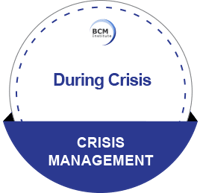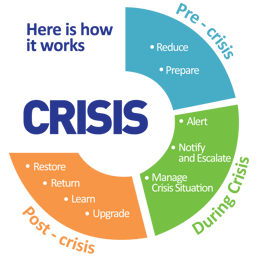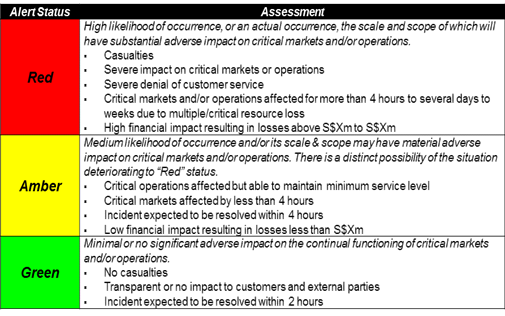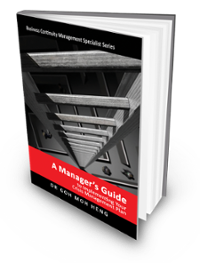During Crisis
The "During Crisis" stage includes:
- Alert
- Notify and Escalate
- Manage Crisis Situation
The diagrams "Alert, Escalate, and Notify Classify Crisis" and "Manage Crisis, Advise, and Recommend" are the flow of events in a typical crisis.
Performance Criteria to Assess the Crisis
The performance criteria to assess the crisis is to:
-
Conduct a risk assessment of all factors impacting the response;
- Conduct an initial assessment of resources required;
- Identify constraints that may impede the response; and
- Identify and assess initial response options.
Alert
- Develop indicators that signify an event that may be or could be liable to cause a significant impact on the organization.
Refer to the diagram below for the Alert Status. It is a sample of the “Red-Amber-Green” alert status and a description of the assessment.

Alert Status
- Receive initial notification.
- Track varied notifications and ensure that the right information gets to the right individual.
When a crisis occurs, people want to know what happened. Crisis Management experts often talk of an information vacuum being created by a crisis. The news media will lead the charge to fill the information vacuum and be a key source of initial crisis information. If the organization having a crisis does not speak to the news media, other people will be happy to talk to the media. These people may have inaccurate information or may try to use the crisis as an opportunity to attack the organization. As a result, crisis managers must have a quick response.

Event Flow for Crisis
Performance Criteria to Implement the CM Plan
The performance criteria for implementing the CM plan is to:
- Identify appropriate crisis management plan(s), including contingency plans if required;
- Manage response to the plan and available personnel/equipment;
- Prioritize responses taking into account the needs of stakeholders;
- Modify plan and deploy additional resources as required; and
- Monitor, evaluate and adjust resto
- ration strategies as required.
Notify and Escalate
- Notify the status of an ongoing incident
- Escalate the status of an event to a level of crisis or disaster when it potentially will begin to cause a significant impact on the organization
In preparing a response to the situation, staff members from the organization must determine if the issue should be addressed or if it will resolve itself. The issue is deemed as threatening if it could negatively impact profits, be detrimental to the company’s reputation, generate undesirable media attention or result in close government scrutiny. Recognizing the seriousness of the problem is essential in generating an appropriate response.
Classify Crisis
- Identify a crisis.
- Actions are taken to identify, assess and classify the severity of the crisis.
Manage Crisis Situation
- Respond to a sudden event that poses a significant threat to the organization.
- Activate CM systems, CM plan and procedures and Crisis response organization.
- Prevent further damage and reduce the effects of the crisis.
- When a crisis hits, you may try to hide the problem so that it goes unnoticed, therefore making it less damaging.
.png?width=1608&name=Event%20Flow%20for%20Crisis%20(Continue%20from%2012-4).png)
Event Flow for Crisis (Continue from the previous workflow)
Advice and Recommend
- Continue providing advice to CM initiatives
- Notify CM contacts
- Activate Command Centre
- Provide advice and recommendations to CM Team
- Monitor and resolve
Goh, M. H. (2016). A Manager’s Guide to Implement Your Crisis Management Plan. Business Continuity Management Specialist Series (1st ed., p. 192). Singapore: GMH Pte Ltd.
Extracted from During Crisis
Find out more about Blended Learning CM-300 [BL-CM-3] & CM-5000 [BL-CM-5]
 |
 |
 |
 |
![TMM [BL-CM-5]](https://no-cache.hubspot.com/cta/default/3893111/54680a64-9914-4958-8cec-1bc451ed5053.png) |
![[BL-CM] [5] Register](https://no-cache.hubspot.com/cta/default/3893111/82024308-16f4-4491-98be-818a882c6286.png) |
 |
Please feel free to send us a note if you have any of these questions to sales.ap@bcm-institute.org |  |







